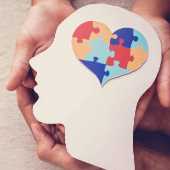Search here

22-Aug-2022
Can Children also have Mental Illnesses?
About 5 million children in the US have a serious mental illness (significantly interfering with daily life). Each year, 20% of American children suffer from mental illness. The term 'mental illness' is incorrect because there are many 'physical' factors that play a role in the pathogenesis of mental disorders, including genetics and brain chemistry. Therefore, many mental disorders can be effectively treated with medication, psychotherapy (a form of counseling), or a combination of the two.
Children's mental health
Diagnosing a child's mental disorder can be difficult for health care providers. Unlike adults, children experience many physical, mental, and emotional changes during their natural growth and development. They also participate in learning to communicate, adapt and interact with other people and the world around them.
Furthermore, each child develops at his or her own pace, and what is considered 'normal' in a child encompasses a wide range of behaviors and abilities. For these reasons, any diagnosis of a mental disorder must take into account how well the child is functioning at home, in the family, at school, and with peers, as well as the child's age and symptoms.
What are the most common mental illnesses in children?
There are several types of mental disorders that affect children and adolescents, including:
Anxiety disorder: A child with an anxiety disorder responds to certain objects or situations with fear and dread, as well as physical symptoms of anxiety (irritability), such as a fast heartbeat and sweating.
Attention Deficit Hyperactivity Disorder (ADHD): Attention Deficit Hyperactivity Disorder (ADHD): Children with ADHD typically have difficulty paying attention or concentrating, do not follow instructions, and are easily bored or frustrated with tasks. They are also constantly on the move and tend to be impulsive (don't think before you act).
Disruptive conduct disorder: Children with this disorder typically ignore rules and often become disruptive in structured settings such as schools.
Pervasive Developmental Disorder: Children with this disorder have a confused mindset and usually have difficulty understanding the world around them.
Eating Disorders: Eating disorders include severe emotions and attitudes, as well as abnormal behaviors related to weight and/or food.
Selection disorders: disorders that affect the behavior related to the use of baths. Enough, bed linen is the most common choice disorder.
Training and communication disorders: children with these disorders have problems with thoughts and ideas, as well as storage and processing of information.
Emotional (mood) disorders: These disorders include pain and/or rapidly changing moods, depression, and bipolar disorders. The latter diagnosis is called a mood disorder, a childhood and adolescent condition characterized by chronic or persistent anger and frequent outbursts.
Schizophrenia: This disorder involves distorted perceptions and thoughts.
Tic Disorder: This disorder causes repetitive, sudden, involuntary, and often meaningless movements and sounds called tics.
Some of these disorders, such as anxiety disorders, eating disorders, mood disorders, and schizophrenia, can affect both adults and children. Others do not begin in childhood but may continue into adulthood. It is not unusual for a child to have multiple conditions.
What is the future of children with mental disorders?
Without treatment, many mental disorders can persist into adulthood and cause problems in all areas of adult life. Despite the risk of suicide, there are many problems with unsuccessful psychological disorders, including alcohol or drug addiction and self-destructive behavior.
If they are right and early, many children can fully recover from mental disorders or successfully monitor symptoms. While some children become adults with disabilities due to chronic or serious conditions, many people with mental disorders such as depression or anxiety can lead full and productive lives.
Can mental disorders in children be prevented?
Most mental disorders are caused by a combination of factors and cannot be prevented. However, many painful and disabling effects of mental illness can be prevented or at least minimized if symptoms are identified and treatment is started early.

Student
An inquisitive individual with a great interest in the subjectivity of human experiences, behavior, and the complexity of the human mind. Enthusiased to learn, volunteer, and participate. Always driven by the motive to make a difference in the sphere of mental health - and normalize seeking help through a sensitive and empathetic approach
Join Our Newsletter
Subscribe to our newsletter to receive emails about new views posts, releases and updates.
Copyright 2010 - 2025 MindStick Software Pvt. Ltd. All Rights Reserved Privacy Policy | Terms & Conditions | Cookie Policy